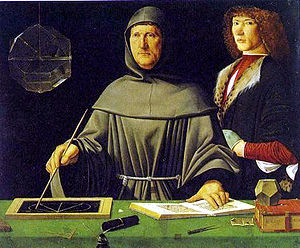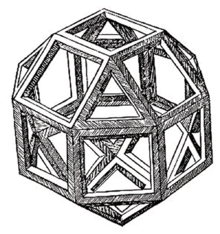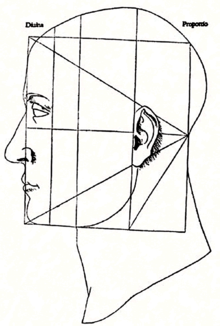- Luca Pacioli
-
 Portrait of Luca Pacioli, traditionally attributed to Jacopo de' Barbari, 1495 (attribution controversial).[1]
Portrait of Luca Pacioli, traditionally attributed to Jacopo de' Barbari, 1495 (attribution controversial).[1]
Fra Luca Bartolomeo de Pacioli (sometimes Paccioli or Paciolo; 1446/7 – 1517) was an Italian mathematician, Franciscan friar, collaborator with Leonardo da Vinci, and seminal contributor to the field now known as accounting. He was also called Luca di Borgo after his birthplace, Borgo Sansepolcro, Tuscany.
Contents
Life
Luca Pacioli was born in 1447 in Sansepolcro (Tuscany) where he received an abbaco education. This was education in the vernacular (i.e. the local tongue) rather than Latin and focused on the knowledge required of merchants. He moved to Venice around 1464, where he continued his own education while working as a tutor to the three sons of a merchant. It was during this period that he wrote his first book, a treatise on arithmetic for the boys he was tutoring. Between 1472 and 1475, he became a Franciscan friar.
In 1475, he started teaching in Perugia, first as a private teacher, from 1477 holding the first chair in mathematics. He wrote a comprehensive textbook in the vernacular for his students. He continued to work as a private tutor of mathematics and was, in fact, instructed to stop teaching at this level in Sansepolcro in 1491. In 1494, his first book to be printed, Summa de arithmetica, geometria, proportioni et proportionalità, was published in Venice. In 1497, he accepted an invitation from duke Ludovico Sforza to work in Milan. There he met, collaborated with, lived with, and taught mathematics to Leonardo da Vinci. In 1499, Pacioli and Leonardo were forced to flee Milan when Louis XII of France seized the city and drove out their patron. Their paths appear to have finally separated around 1506. Pacioli died at age 70 in 1517, most likely in Sansepolcro where it is thought that he had spent much of his final years.
Mathematics
 The first printed illustration of a rhombicuboctahedron, by Leonardo da Vinci, published in De divina proportione.
The first printed illustration of a rhombicuboctahedron, by Leonardo da Vinci, published in De divina proportione.
 Woodcut from De divina proportione illustrating the golden ratio as applied to the human face.
Woodcut from De divina proportione illustrating the golden ratio as applied to the human face.
Pacioli published several works on mathematics, including:
- Tractatus mathematicus ad discipulos perusinos (Ms. Vatican Library, Lat. 3129), a textbook of almost 600 pages, dedicated to his students at the University of Perugia where Pacioli was teaching from 1477 to 1480. The manuscript was written between December 1477 and completed on 29 April 1478. It contains 16 sections on merchant arithmetic, such as barter, exchange, profit, mixing metals, and algebra. One part of 25 pages is missing from the chapter on algebra. A modern transcription has been published by Calzoni and Cavazzoni (1996) as well as a partial translation of the chapter on partitioning problems (Heeffer, 2010).
- Summa de arithmetica, geometria, proportioni et proportionalità (Venice 1494), a textbook for use in the schools of Northern Italy. It was a synthesis of the mathematical knowledge of his time and contained the first printed work on algebra written in the vernacular (i.e. the spoken language of the day). It is also notable for including the first published description of the method of bookkeeping that Venetian merchants used during the Italian Renaissance, known as the double-entry accounting system.The system he published included most of the accounting cycle as we know it today. He described the use of journals and ledgers, and warned that a person should not go to sleep at night until the debits equalled the credits. His ledger had accounts for assets (including receivables and inventories), liabilities, capital, income, and expenses — the account categories that are reported on an organization's balance sheet and income statement, respectively. He demonstrated year-end closing entries and proposed that a trial balance be used to prove a balanced ledger. Also, his treatise touches on a wide range of related topics from accounting ethics to cost accounting. Remarkably, in the solution for one problem he presented in the book he used an approximation of 100*log 2, more than 100 years before Napier and Briggs.[2]
- De viribus quantitatis (Ms. Università degli Studi di Bologna, 1496–1508), a treatise on mathematics and magic. Written between 1496 and 1508 it contains the first reference to card tricks as well as guidance on how to juggle, eat fire and make coins dance. It is the first work to note that Leonardo was left-handed. De viribus quantitatis is divided into three sections: mathematical problems, puzzles and tricks, and a collection of proverbs and verses. The book has been described as the "foundation of modern magic and numerical puzzles", but it was never published and sat in the archives of the University of Bologna, seen only by a small number of scholars since the Middle Ages. The book was rediscovered after David Singmaster, a mathematician, came across a reference to it in a 19th-century manuscript. An English translation was published for the first time in 2007.[3]
- Geometry (1509), a Latin translation of Euclid's Elements.
- De divina proportione (written in Milan in 1496–98, published in Venice in 1509). Two versions of the original manuscript are extant, one in the Biblioteca Ambrosiana in Milan, the other in the Bibliothèque Publique et Universitaire in Geneva. The subject was mathematical and artistic proportion, especially the mathematics of the golden ratio and its application in architecture. Leonardo da Vinci drew the illustrations of the regular solids in De divina proportione while he lived with and took mathematics lessons from Pacioli. Leonardo's drawings are probably the first illustrations of skeletonic solids, which allowed an easy distinction between front and back. The work also discusses the use of perspective by painters such as Piero della Francesca, Melozzo da Forlì, and Marco Palmezzano. As a side note, the "M" logo used by the Metropolitan Museum of Art in New York City is taken from De divina proportione.[4]
Translation of Piero della Francesca's work
The majority of the second volume of Summa de arithmetica, geometria, proportioni et proportionalità was a slightly rewritten version of one of Piero della Francesca's works. The third volume of Pacioli's De divina proportione was an Italian translation of Piero della Francesca's Latin writings On [the] Five Regular Solids. In neither case, did Pacioli include an attribution to Piero. He was severely criticized for this and accused of plagiarism by sixteenth-century art historian and biographer Giorgio Vasari. R. Emmett Taylor (1889–1956) said that Pacioli may have had nothing to do with the translated volume De divina proportione, and that it may just have been appended to his work. However, no such defence can be presented concerning the inclusion of Piero della Francesca's material in Pacioli's Summa.
Chess
Pacioli also wrote an unpublished treatise on chess, De ludo scacchorum (On the Game of Chess). Long thought to have been lost, a surviving manuscript was rediscovered in 2006, in the 22,000-volume library of Count Guglielmo Coronini. A facsimile edition of the book was published in Pacioli's home town of Sansepolcro in 2008. Based on Leonardo da Vinci's long association with the author and his having illustrated De divina proportione, some scholars speculate that Leonardo either drew the chess problems that appear in the manuscript or at least designed the chess pieces used in the problems.[5][6][7][8]
See also
- List of Roman Catholic scientist-clerics
- Della mercatura e del mercante perfetto
Notes
- ^ RitrattoPacioli.it
- ^ St-and.ac.uk A Napierian logarithm before Napier, John J O'Connor and Edmund F Robertson
- ^ Guardian.co.uk
- ^ The Met Store (Metropolitan Museum of Art shopping catalog), "Renaissance 'M' Bookmark" The Museum claims this origin in its descriptions of many souvenir items decorated with this logo, which it calls the "Renaissance M".
- ^ Times Online: Renaissance chess master and the Da Vinci decode mystery
- ^ International Herald Tribune: Experts link Leonardo da Vinci to chess puzzles in long-lost Renaissance treatise
- ^ Winnipeg Free Press: Chess
- ^ Experts link Leonardo da Vinci to chess puzzles
Sources
- Bambach, Carmen (2003). "Leonardo, Left-Handed Draftsman and Writer". New York: Metropolitan Museum of Art. http://www.metmuseum.org/special/Leonardo_Master_Draftsman/draftsman_left_essay.asp. Retrieved 2006-09-02.
- Calzoni, Giuseppe and Gianfranco Cavazzoni (eds.) (1996) Tractatus Mathematicus ad Discipulos Perusinos, Citta di Castello, Perugia.
- Heeffer, Albrecht, "Algebraic partitioning problems from Luca Paccioli’s Perugia manuscript (Vat. Lat. 3129)" in Sources and Commentaries in Exact Sciences, (2010), 11, pp. 3–52
- Pacioli, Luca. De divina proportione (English: On the Divine Proportion), Luca Paganinem de Paganinus de Brescia (Antonio Capella) 1509, Venice
- Taylor, Emmet, R. No Royal Road: Luca Paccioli and his Times (1942)
- Full Biography of Pacioli (St.Andrews)
- Lucas Paccioli - Catholic Encyclopedia article
- Libellus de quinque corporibus regularibus, corredato della versione volgare di Luca Paccioli [facsimile del Codice Vat. Urb. Lat. 632]; eds. Cecil Grayson,... Marisa Dalai Emiliani, Carlo Maccagni. Firenze, Giunti, 1995. 3 vol. (68 ff., XLIV-213, XXII-223 pp.). ISBN 88-09-01020-5
External links
Categories:- 1440s births
- 1517 deaths
- People from Sansepolcro
- 15th-century Italian mathematicians
- 16th-century Italian mathematicians
- Leonardo da Vinci
- Italian accountants
- Italian Roman Catholics
- Magic squares
- Franciscans
- Roman Catholic cleric–scientists
Wikimedia Foundation. 2010.
